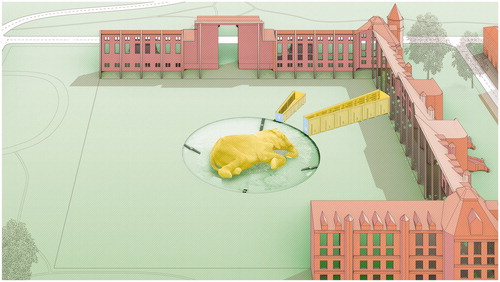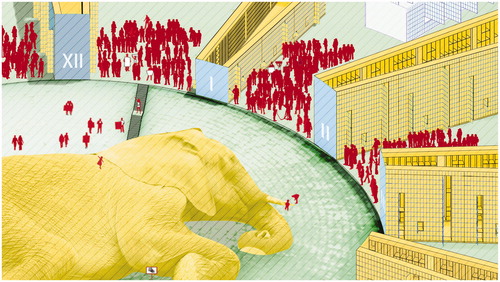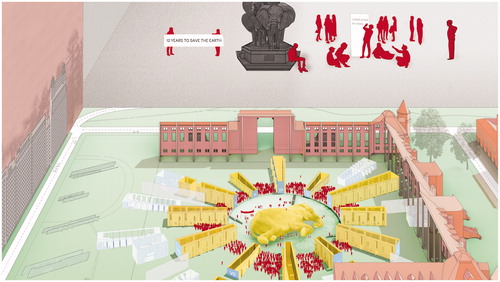Abstract
Elephant in the Room is a speculative ecofeminist fable for the climate crisis. The animation addresses the elephant in the room—the climate emergency—by telling the story of one elephant who takes action to combat environmental injustice and climate change.
The American Museum of Natural History in New York is home to the famous displays of taxidermy dioramas, which, in The Akeley Hall of African Mammals, includes a herd of eight elephants that were largely “made” by Carl Akeley, after whom the hall is named. One of these elephants was shot by President Theodore Roosevelt during the Smithsonian-Roosevelt African Expedition (1909–1910), in which thousands of animals were trapped and killed to become property of the museum. In her environmentalist rebellion, the herd’s African matriarch comes to life charging out of the American Museum of Natural History to stomach the systemic legacies of “the commerce of power and knowledge in white and male supremacist monopoly capitalism,” all outlined by Donna Haraway as the “Teddy Bear Patriarchy.”Footnote1 By taking her demands to the streets, the elephant underlines the role of museums in wider calls for climate justice, which necessary involve a critical revision of the museum’s own legacies, and their myriad entanglements with extractivist environmental histories in the ways that have constructed worlds (and worldviews) that perpetuated division, dispossession, and violence.
The story explores how rethinking the design, purpose, and experience of natural history museums can foster new forms of public pedagogy, in which curatorial practices become a magnifying glass for climate campaigns. Figuration, which bestows personhood onto the elephant, is here a crucial aesthetic method for this moment of crisis. Figures are ‘material-semiotic knots,’ as noted by Donna Haraway. They help us grapple inside the flesh of the world, making entanglements in which diverse clusters of meaning (narratives, discourses, precedents, imaginaries) shape one another through “creating performative images that can be inhabited.”Footnote2 The Elephant in the Room is one such animal fable in an architecture parlante’s clothing. The elephant makes explicit and explains its own function or identity: to affectively engage and generate care for matters and lifeforms that, otherwise, would be neglected or overlooked. It fuses climate purpose and artistic purpose into one (w)hole Trojan Elephant. Such a fable, which is apt to delight and entertain, always makes a fuss about injustice, cruelty, and arrogance. In this sense, the elephant as museum is less a curator—that which manages, administers, or organizes a collection—and more a caretaker, that is someone who takes care of a planet, and with responsibility for keeping a place in good repair. The need to craft such praxis of care and response, or response-ability to stay with the words of Haraway, implies both a design to find out more about an issue and an ethical obligation to become concerned and to act. This story comes at a time when we stand to imagine how we will answer the question of young climate activists: “you knew what you had to know, what did you do?” Academics stand in a special position to provoke, envision, and propose an institutional responsibility and action on the part of the university. Are we architecture educators able to consent to this trust, to accept giving it the power to affect us?
Notes
A visitor to the museum notices small things, caught up in their own interests and the bias this brings. What does this allow to go unaddressed? The elephant in the room, as you may have guessed.
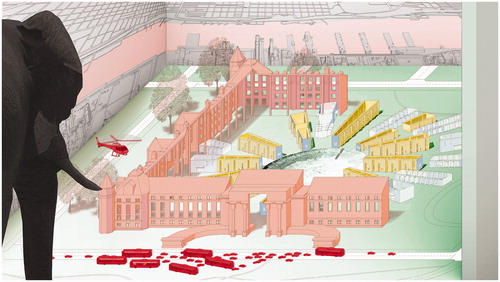
There is no bigger problem often ignored than the climate change we are marching toward. Climate issues have become more robust, As diesel, paraffin, and petrol combust.
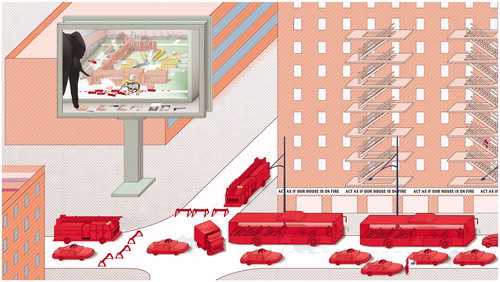
Familiar with the feeling of being dismissed, the elephant trumpets: a crisis does exist! She lets out an alarm call to signal the herd, to stampede into the streets out from where they were stirred.

She broke out of the Museum of Natural History to protest human behavior in all its misery. She occupies Wall Street and protests in Times Square, while sirens serenade and flies buzz in the air.

The African elephant sounds a deafening drum; “Enough is enough! Surely you aren’t all just dumb.” This matriarch elephant and seven more died, just so the museum could become more alive.
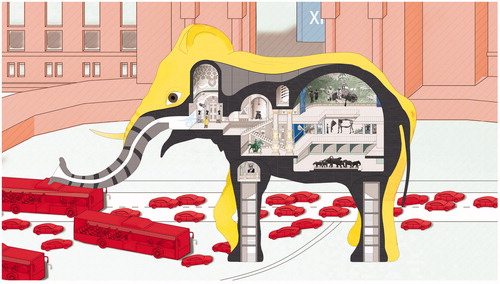
The Hall of African Mammals is where they were taken, waiting over a century for a time to awaken. “The Alarm” is the centerpiece where their bodies were staged, frozen in a nightmare as if they were caged.
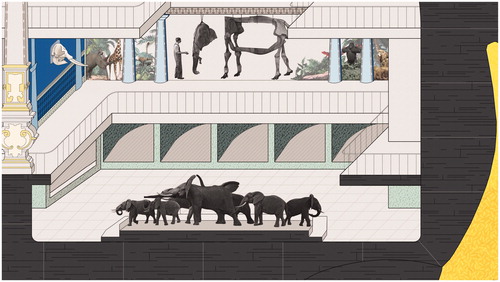
The elephant never forgets the source of its scar. “Speak softly and carry a big stick; you will go far.” A celebrated “conservationist” with a liking for hunting, is the American president the elephant was confronting.
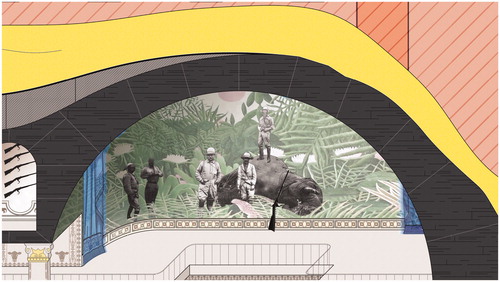
“The Big Stick” is the rifle President Roosevelt had in hand, as he stalked the elephant’s footprints across open land. His son Kermit joined in on the Africa expedition and shot her small calf taking after the politician.
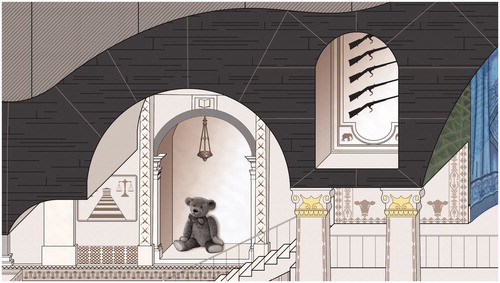
The elephant twitches to life in the Africa Hall. As if no time has passed, she remembers it all. Her reddish-brown eyes with German glass in their place open to look museumgoers in the face.
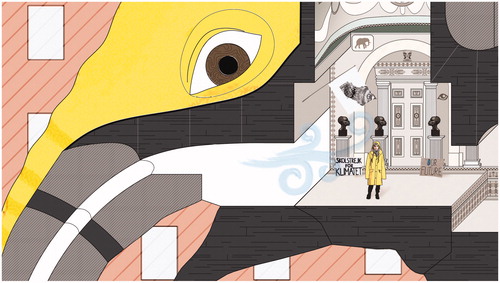
The creature denounces the stuffed Teddy and its monsters. She has had quite enough of environmental imposters; The equestrian statue, the plaque honoring David Koch, were swallowed using her trunk shortly after she woke.
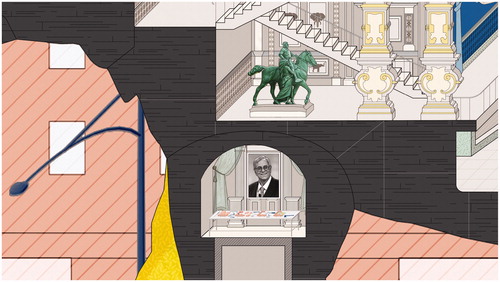
She devours a book that a companion had written on structures of power and knowledge she did not fit in. The “Teddy Bear Patriarchy” is a violent tale of capitalism, supremacy, and the white human male.

With eyes no longer blind she sees what her body can make, the world on her mind that no one can take. She looks around the room and says; “The one thing I know, is that the teddy bear patriarchy will have to go!”
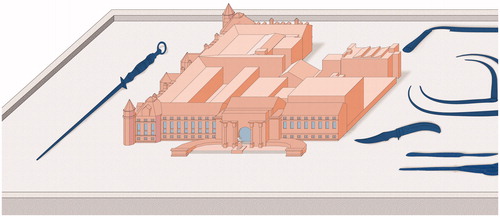
The mammal’s belly rumbles with resonant demands: to decolonize, divest, and dismantle, she firmly stands. Like a calving iceberg, earthquake, or volcanic eruption, her trumpeting call thunders a long-distance disruption.
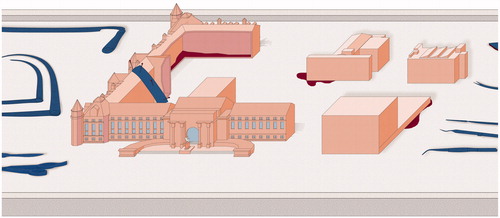
Her revival starts an autopsy fit for the ages, where tools are used to dissect the museum in stages. Natural History becomes an architectural taxidermy, in a plan to make the most avid climate deniers squirmy.
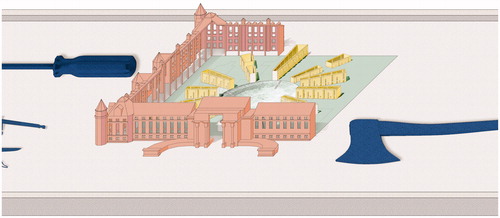
It frames a graveyard where the elephant can finally rest, with the enormous weight she has lifted right off of her chest.

In the garden of a damaged planet no collection is held, only the demand for action—that’s why the elephant rebelled! A Climate Countdown 2 Degrees Clock will keep time and enforce the twelve years that remain for us to panic and change course.
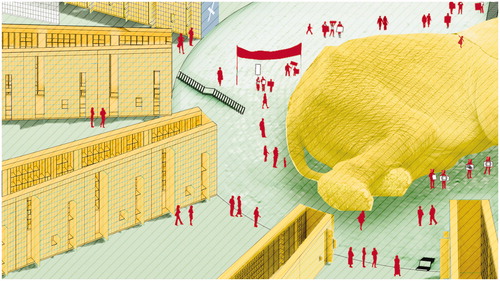
Notes
Additional information
Notes on contributors
Rania Ghosn
Rania Ghosn is founding partner of Design Earth and associate professor of architecture and urbanism at Massachusetts Institute of Technology. She is founding editor of the journal New Geographies, editor of Landscapes of Energy (2010), and co-author of Geographies of Trash (Actar, 2015) and Geostories: Another Architecture for the Environment (2018; 2020).
El Hadi Jazairy
El Hadi Jazairy is founding partner of Design Earth and associate professor of architecture at University of Michigan Taubman College. He is founding editor of the journal New Geographies, editor of Scales of the Earth (2011), and co-author of Geographies of Trash (Actar, 2015) and Geostories: Another Architecture for the Environment (2018; 2020).
Notes
1 Donna Haraway, “Teddy Bear Patriarchy: Taxidermy in the Garden of Evil,” Social Text no. 11 (Winter 1984–1985): 20–64.
2 Donna Haraway, Modest_Witness@Second_Millennium.FemaleMan©_Meets_OncoMouseTM. Feminism and Technoscience (London: Routledge, 1997).

